In less than a year, Walt Disney would have his Disneyland... whatever it took.
I couldn’t believe my eyes... We were driving through orange groves and dirt roads. I didn’t tell him what I really thought - that he was out of his mind. After all, it was 45 minutes from where people lived and there was nothing there.
At first glance, the 160 acres in Anaheim, California didn’t seem the ideal place to build an amusement park. Anaheim was mostly an agricultural city, and much of the infrastructure that connected the other parts of Los Angeles hadn’t made its way there yet. The land itself not only consisted of orange groves and walnut trees, but a number of farmsteads. Before construction could begin, the land itself needed to be cleared.
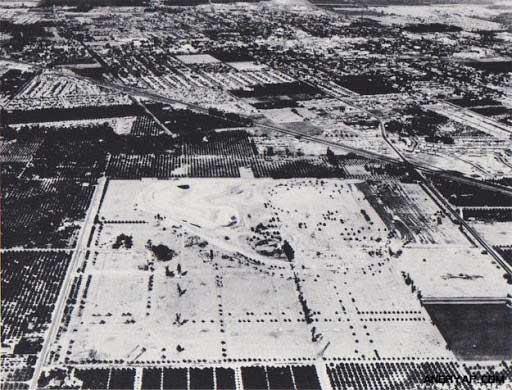
The first stage was to prepare and grade the site. While many of the families living on the site were in the process of moving, grading began to sculpt the landscape to their needs, which included lakes, rivers and a large embankment circling the park for privacy and for a steam engine that would circle it. A number of the farmhouses were temporarily repurposed as construction offices.
A major issue with the site was the lack of basic infrastructure such as electricity and water. Nearly two miles of piping was laid for sewage, and the City of Anaheim voted to annex the land around the site to connect it to the city’s main services. This would be a fortuitous decision, as Anaheim would grow from an agricultural area to the second-largest city in Los Angeles by the end of the century, thanks to the popularity of Disneyland.
Another challenge that quickly presented itself was the very soil on which the park was being built. When water was first run into one of the artificial rivers, it immediately soaked into the ground. Very quickly, clay was added to all lake and river beds to waterproof them.
Once the grading was complete and the land prepared, proper construction on Disneyland could begin.
...part idealised past and part conceivable future, tinged with a romanticised eroticism...
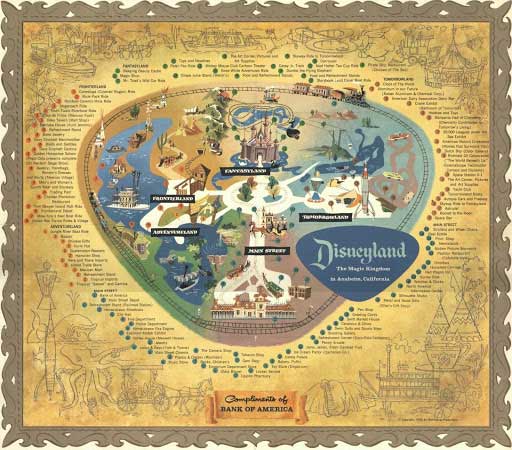
While work continued at the site, the artists, technicians and architects at WED Enterprises were in full-swing designing the world that would be built on it. Where other theme parks had a charming slap-dash quality, Disneyland would be a complete experience, where everything down to the rubbish bins would be perfectly calibrated for maximum enjoyment and synergy.

Disneyland would consist of five themed areas. After visitors arrived through the main gate, styled to look like a vintage railway station, they would proceed up Main Street USA, modeled after an idealised version of a midwestern American street at the turn of the century. There would be similarities to the same architecture being designed for Lady and the Tramp, driven by Walt’s romantic memories of Marceline, Missouri, where he had lived for a short while as a child. The street would include a train station, a town square, a fire station, shops and emporiums. Main Street USA would also be designed as an optical illusion, using forced perspective to give it a sense of height without having to build to scale - buildings would be built at 3⁄4 scale on the first level, 5⁄8 on the second level, and 1⁄2 scale on the third, reducing the scale by 1⁄8 each level up.
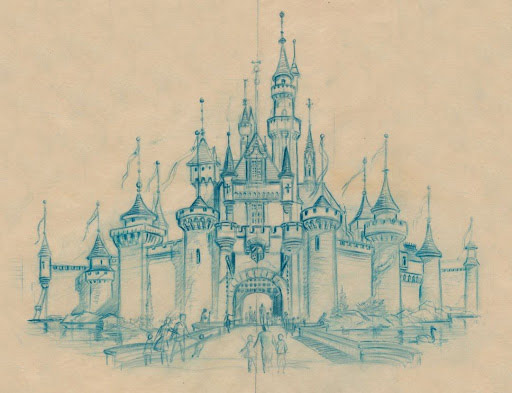
At the far end of Main Street would stand 'Sleeping Beauty’s' castle, a grand recreation of the castle featured in the film that was now in production. This would be the entrance to Fantasyland, the area of the park themed more directly on the animated films. "What youngster has not dreamed of flying with Peter Pan over moonlit London," said Walt, "or tumbling into Alice's nonsensical Wonderland? In Fantasyland, these classic stories of everyone's youth have become realities for youngsters – of all ages – to participate in." Walking across the drawbridge and through the castle, visitors would be greeted by dark rides, a carousel and several other attractions themed around the films, and styled in a medieval European fashion.
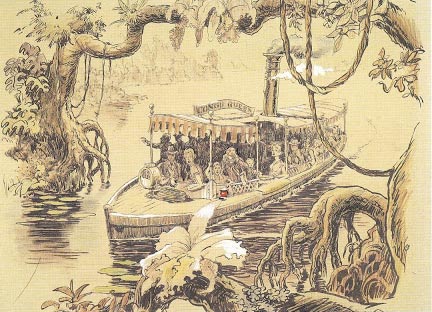
In front of the castle would be a square where visitors could head to the other areas of the park. The first would be Adventureland, where visitors could enjoy exotic jungle environments and animals. The centrepiece would be the Jungle Cruise, where they would see extraordinary animatronic animals designed as close to real life as possible. That technology would be used to its full effect in the Enchanted Tiki-Room, where animatronics birds would be perfectly synced to corresponding sounds.
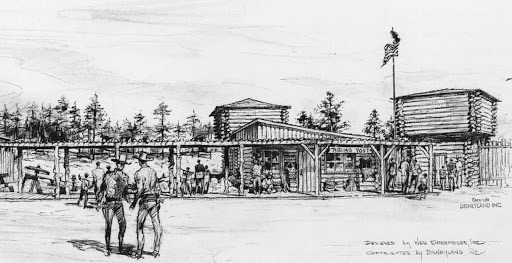
Continuing along, you would find Frontierland, Walt’s attempt to bring to life another "colourful" aspect of American history. This area would be themed after America’s frontier past, and link directly with Walt’s desire to educate visitors on American history. "All of us have cause to be proud of our country's history," said Walt, "shaped by the pioneering spirit of our forefathers. Our adventures are designed to give you the feeling of having lived, even for a short while, during our country's pioneer days." Visitors would be able to travel along the Rivers of America on the Mark Twain Riverboat, take the Big Thunder Mountain Railroad and enjoy other attractions themed around frontier and Native American culture (all of the latter filtered through white American 1950’s stereotypes).
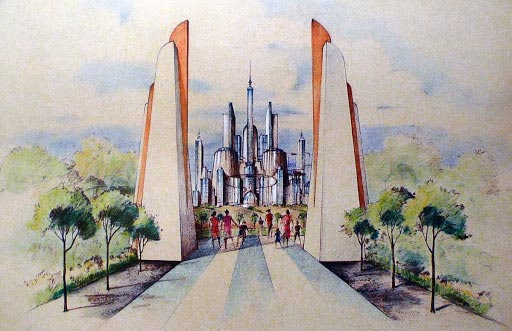
The last of the five realms of Disneyland would be its strangest - Tomorrowland. Rather than invoking America’s past, it was Walt’s vision of America’s future, a fascination that was quickly growing in his mind. "Tomorrow can be a wonderful age," said Walt. "Our scientists today are opening the doors of the Space Age to achievements that will benefit our children and generations to come. The Tomorrowland attractions have been designed to give you an opportunity to participate in adventures that are a living blueprint of our future." Ward Kimball collaborated with scientists Wernher von Braun, Willy Ley, and Heinz Haber, offering visitors such attractions as a Rocket To The Moon in an imagined future for America in 1986.
The ideas were incredible, but also insanely ambitious. Nothing even remotely like it existed, which meant that, no matter how many smaller parks Walt looked to for inspiration, he and the team at WED were travelling in the dark, conceiving something for which they had no reference. This level of immersion would require remarkable design and engineering, much of which would barely have time to be tested and perfected before opening to the public.
Some members of the team gently suggested that perhaps the July 1955 opening deadline wouldn’t be possible, and it might be worth delaying it. Walt would hear no talk of delays though - he wanted his vision realised as quickly as possible. He hadn’t felt this creatively energised since the making of 'Snow White', and his long-dormant creative fountain was overflowing.
And besides, they’d promised a large television audience that the park would be ready on time.
Since the series was conceived as a way of financing Disneyland, it was decided that it should also promote Disneyland, even down to its choice of title. Disneyland the TV series would be hosted by Walt, and would build excitement for the park by theming each episode around one of the four Lands - Fantasyland, Adventureland, Frontierland and Tomorrowland. Walt would also offer updates on the progress of the park itself. Never letting an opportunity go to waste, Walt also decided that the series should promote other Disney projects, including their lavish production of 20,000 Leagues Under the Sea due for release in December 1954.
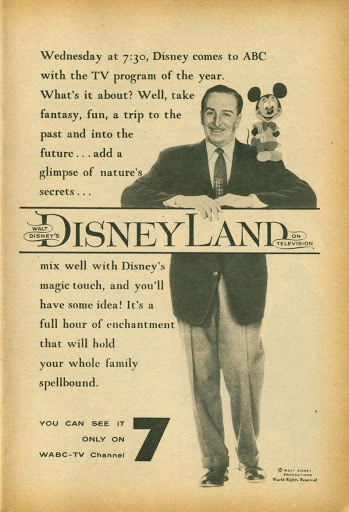
At first, Walt was reticent about hosting the show. He had never had an issue with appearing and speaking in public, but hosting One Hour in Wonderland in 1950 had been a stressful experience. Many of his closest friends were amongst the top personalities and entertainers in the industry, and he felt inadequate by comparison. What was also becoming clear though was that the public saw Disney the Brand and Disney the Man as one and the same, and his public persona would be necessary in winning over the audience.

With a burst of fairy dust from Tinkerbell and the iconic recording of Cliff Edwards singing 'When You Wish Upon a Star', 'Disneyland' premiered on the 27th of October 1954. The first episode, titled 'The Disneyland Story', outlined the plans for the series and gave the public their first glimpse at the park itself. The episode also included previews of what was to come, with behind-the-scenes looks at 20,000 Leagues and Sleeping Beauty. Though he was nervous, Walt turned out to be the perfect host - gentle, good-humoured and relatable. He spoke to the audience with a conversational tone that drew them in, and for many, was synonymous with what they knew of the man from his work.
These kinds of programs now seem relatively straight forward, but in 1954, 'Disneyland' was revelatory. This was the first time a major studio had launched a series themed around their work, and the first time a major business venture formed the basis for a television show. Walt was also relinquishing any scrap of anonymity he had. His face and voice were now in people’s homes, in their living rooms, a part of their lives. In many ways, it was Walt Disney Productions laid bare. If it had failed, it might have been an embarrassment for Walt and the studio, and very bad news for the Disneyland park. Instead, over 28 million televisions were tuned into the program that first night, over half of the viewing public.
Rather than reuse pre-existing material, the four realms were represented by new original material. 'Adventureland' saw material from the popular True-Life Adventure theatrical shorts making the transition to television, along with documentary footage from cultures around the world and material related to '20,000 Leagues'. Much like its equivalent in the park, 'Fantasyland' focused on Disney filmmaking, looking at how the films were made and demonstrating animation techniques and technology. Likewise, 'Tomorrowland' featured experts and scientists discussing technology of the future.
None had as great an impact though as the mini-series created to feature on 'Frontierland'. For this section, Walt Disney Productions created a three-episode story on American frontiersman and folk hero Davy Crockett, played by Fess Parker. This was another part of Walt’s desire to celebrate American history through the Disneyland venture. On the first episode in October, they previewed the series with Parker performing the theme song 'The Ballad of Davy Crockett', which was written by George Bruns and Thomas W. Blackburn.
The first episode, Davy Crockett, Indian Fighter, aired on the 15th of December 1954, with Crockett brokering a truce between a Native American tribe and a military outpost. To everyone’s great surprise, the show was an enormous hit, and by the time the last of the three episodes aired in February, it had become a phenomenon.
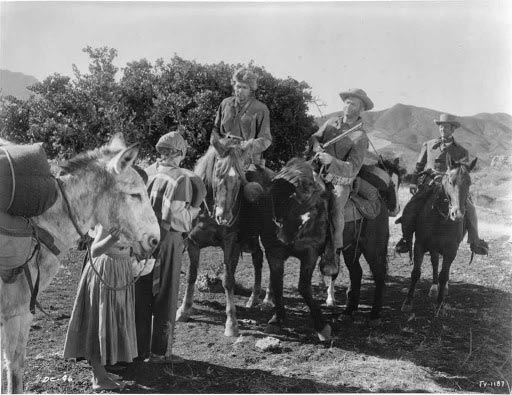
The studio was taken off-guard by the success, but quickly realised it was something they could capitalise on. They rushed out merchandise, the most popular items being replica coonskin hats and bubblegum cards. After watching the first episode the night it aired, Cadence Records president Archie Bleyer contacted singer Bill Hayes and asked if he would be interested in covering the theme song. Hayes agreed, and the next day recorded it in one take at the RCA Studios in New York. His cover would shoot to the top of the Billboard charts, followed closely by other versions from Fess Parker, Tennessee Earnie Ford and Mac Weisman. Not only did Disney and ABC have a hit show on their hands, but a hit song to go with it. The following year, those three episodes were edited together and released theatrically as 'Davy Crockett, King of the Wild Frontier', and further episodes aired in November.
By accident, Disney’s Davy Crockett became a major cultural phenomenon, enough so that debate began to swirl over whether Crockett was a historical figure deserving of such attention. There was also criticism of its historical inaccuracy, but none of this slowed its popularity. Disney had fashioned him into the ultimate American folk hero of the 50s - charming, loyal, wary of authority and committed to the wholesome values of the roles of men and women. The fact that it wasn’t accurate didn’t matter, to Walt in particular. Just as he was doing with the physical Frontierland, he was crafting a narrative of America more fitting to his ambitions for it. The darker details of the past didn’t figure into the vision of American history he wanted to believe in, something that had been evident right back to 'Song of the South' a decade earlier.
In the meantime, 'Disneyland' was doing exactly what they had hoped it would. Interest in the park was building to a fever pitch, with more and more Americans tuning in to chart its progress. Cameras were set up all over the site at Anaheim to capture its creation, and that footage featured in the series. What the public saw was a magical kingdom coming to life. What was happening on the ground though was far from magical.

Construction on Disneyland is a story of statistics. 5,000 cubic metres of concrete were laid, along with one million square feet of asphalt paths. Walt claimed that half a million dollars was spent on the acres and acres of trees, plants and shrubbery, including three palm trees that were rescued from the site. The scale of what they were trying to achieve was enormous, and as the work continued to grow, so too did the personnel required to pull it off.
In February 1955, landscape architect Ruth Shellhorn was brought on to design Main Street USA, Tomorrowland and the castle forecourt, but soon found herself working on other areas of the park. Tomorrowland was a particular concern - six months away from opening, construction hadn’t even started yet. Many of the rides and attractions were also untested, including the animatronics that had to be able to work effectively in water.
Despite the deadline, Walt was insistent that everything had to be perfect. He visited the site every day, walking around and shouting orders at everyone. If something wasn’t up to his standard, no matter how much it would cost or how much time it would take, Walt ordered it redone. On occasion, Walt would even roll up his sleeves and pitch in himself. "Walt knew that if details are missing or incorrect, you won’t believe in the story," said Disney artist and Disneyland designer John Hench. "If one detail contradicts another, guests will feel let down or even deceived."
As they throttled towards opening day, it became clear that not everything would be ready. A number of attractions hadn’t been cracked yet, and Tomorrowland was simply taking too long. In the final weeks of construction, the workforce had grown to 2500 people, many working double shifts and crane operators working in rotating shifts around the clock. The budget had also tripled to $17 million.
Walt may have insisted on ignoring the approaching deadline, but in May 1955, he was suddenly forced to. That month, plumbers and asphalt workers in Orange County went on strike. The dispute ended up taking months to solve, ending only days before the opening. Walt was delivered a difficult, and later fateful, ultimatum - he could either have the drinking fountains ready and hooked-up, or the restrooms. He decided on the restrooms. "People can buy Pepsi cola," he said, "but they can’t pee in the street." To ensure that the restrooms were completed on time, Walt paid the plumbers a higher wage retroactively.
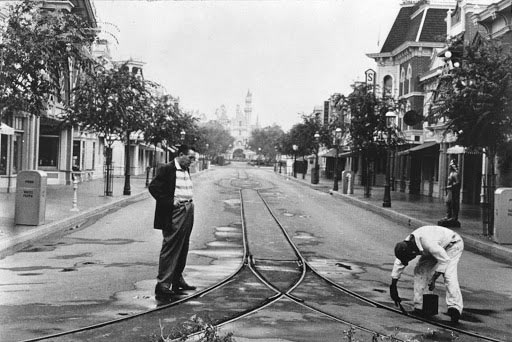
On the Saturday 16th, the day before the press preview, workers were frantically doing everything they could to have the park as finished and presentable as possible. Even Walt worked with them late into the night and through to the following morning, paintbrush in hand to finish the Giant Squid puppet while ordering more changes to be made. When the sun finally rose the following day, time was up. By some miracle, they had completed Disneyland in time. Now its future lay in the hands of the public.
The live ABC broadcast of the opening, 'Dateline Disneyland', was due to begin at 4:30pm, and throughout the morning, a record 24 cameras were set up around the park, along with miles of cable. It would be hosted by TV and film personalities (and Walt’s friends) Art Linkletter, Bob Cummings and Ronald Reagan, and would run for an hour and a half. A broadcast of this scale had never been attempted before, enough so that, in his introduction, Linkletter apologised in advance for any technical mistakes that might occur.
The first visitors to Disneyland were intended to be invited guests of the international press, along with celebrities and important dignitaries. They were due to arrive in two hour blocks to avoid congestion, and many had tickets where they could fill out themselves the number of guests they would be bringing. At 2.30pm, the first visitors entered Disneyland, and at 4.30pm, 'Dateline Disneyland' began.
Before the first Main Street parade, Walt was joined by the Mayor of Anaheim and others, to officially dedicate the opening of the park. Stepping forward, Walt delivered both for those present and those watching on television his opening speech.
To all who come to this happy place; welcome. Disneyland is your land. Here age relives fond memories of the past…and here youth may savor the challenge and promise of the future. Disneyland is dedicated to the ideals, the dreams and the hard facts that have created America…with the hope that it will be a source of joy and inspiration to all the world.
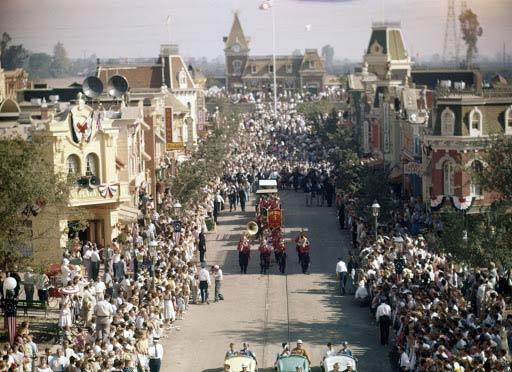
What visitors found in Disneyland was not quite what they expected. A number of the attractions weren’t ready yet, and others, such as Mr Toad’s Wild Ride, shut down due to an overload in the power grid. A gas leak in Fantasyland meant that the entire area, which was one of the main attractions of the park, was closed for most of the first day. There were even instances where women got their heels stuck in the recently-lain asphalt that hadn’t had time to set yet.
There were also issues with the broadcast. At least half of the cameras didn’t work on the day, and many visitors stumbled over the cables snaking across the park. On occasion, the broadcast would live cross to another location where the presenter wasn’t ready, and even Walt’s dedication of Tomorrowland had to be restarted when he was told incorrectly that they weren’t live yet, even though they were.
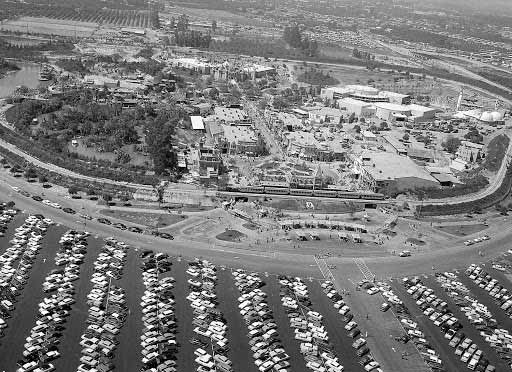
These issues paled in comparison though to two major problems that no-one could have anticipated. Despite the first day being invited guests only of around 15,000, the crowds in the park swelled to an uncontrollable 28,000. Many ticketed visitors had taken advantage of the option on their tickets to bring as many guests as they would like, and brought in larger groups than expected. There were also a number of counterfeit tickets used for entry, and some people even climbed the fence to get into the park. This was far too many people for anyone to be able to enjoy the park fully, especially one that wasn’t yet operating at its full capacity. Waits for rides and attractions were so long that parents began throwing their children over the crowds to get in.
The issue of overcrowding was further exacerbated by the unexpected heat. Temperatures rose to 101 degrees fahrenheit, and Walt’s decision to not have the water fountains hooked up in time was coming back to haunt him. Many visitors saw it as a stunt by Pepsi, who was sponsoring the park, to drive up sales, and many food vendors quickly ran out of food. Rather than a magical experience, the first day at Disneyland was turning into a flop.
No one watching at home though would have had a clue. Despite the technical difficulties, 'Dateline Disneyland' attracted an astounding 90 million viewers, over half the population. What they saw was the promise of the television show coming to life before their eyes, and visiting Disneyland became the dream for many American families.
The reviews from that opening day were the kind Walt had feared. "Walt’s dream is a nightmare," wrote H.W. Mooring in the Los Angeles Times, "a fiasco the likes of which I cannot recall in thirty years of show life." They were put off by the lack of crowd management, the laborious wait times and the unfinished attractions, and expressed that frustration in print. In years to come, the company would nickname the opening day of Disneyland as "Black Sunday".
There was one review though that offered a window into Disneyland’s future. "To sum up, Disneyland was a disappointment," wrote Sheila Graham, "but don’t be discouraged, boys and girls - Walt Disney has always been a smart trader, and I’m sure there’ll be some changes made."
He saw this as his personal statement about who he was, who the Walt Disney company was, and who he thought America was. He believed in this so strongly.”
The International Press Preview may not have gone according to plan, but there was no time to make changes. At 2am the following morning, the first public visitors began to line up to see the park for themselves. The first in line was 22-year old college student Dave MacPherson. 6000 people waited in line behind him. "I decided I wanted to be the first in line," he said in an interview in 2019, "The first person to go into the park who wasn’t a relative of Walt’s or some celebrity. The first regular guy to go in through the front door."
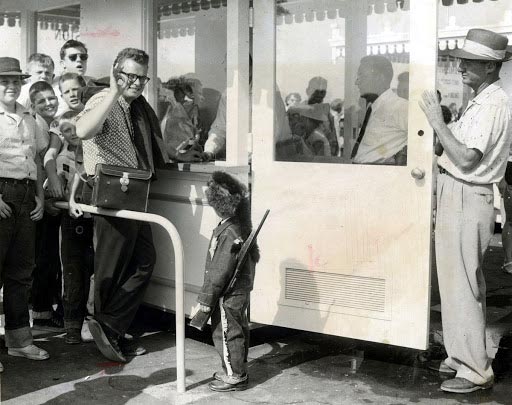
At 2.30pm, MacPherson paid his $1 and became Disneyland’s first paying customer. To his surprise, he was then given a lifetime pass, allowing him to visit the park every year, which he still does to this day. Awaiting MacPherson and that first group of visitors was Walt Disney himself, standing inside the gates to greet them.
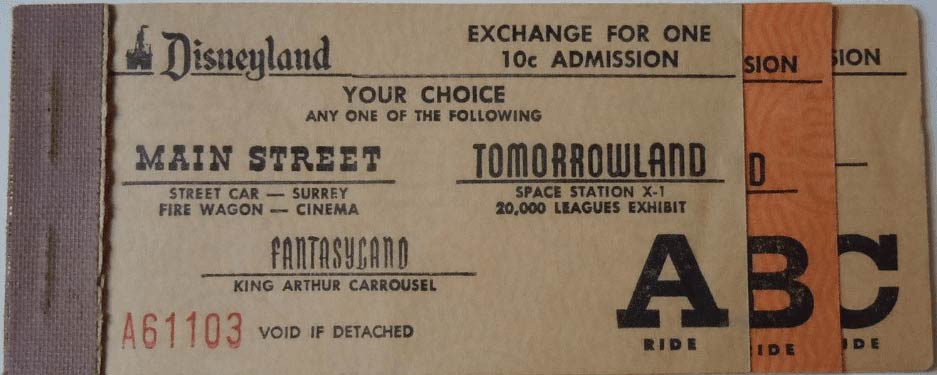
While a ticket gave visitors admission to the park, it didn’t guarantee them access to the attractions inside. In a move to garner more income for the park, visitors had to buy special ticket books that gave them access to particular attractions depending on which ticket they had. Coupon books were introduced to make things easier, with tickets ranging from A Tickets for minor attractions at 10 cents, to more expensive C Tickets for more popular attractions.
The first summer for Disneyland was an incredibly busy one, with barely a moment to breathe and take stock. By 1955, American families had begun to embrace the culture of recreational travel, and they now had a place suitable for the whole family. As a result, it took a long time to make the changes necessary after the stumbled opening. "There really was no way to stop and rebuild things that first summer season," remembered Imagineer Bob Gurr in 2016, "just weld and fix, weld and fix... Some of the refinements were easy to implement, like where shade is needed, how queue lines should work, and how ride operators can be trained to handle any human situation. Long-term improvements would have to wait until fall when all our young guests were back in school and we could catch our breath."

Walt also wanted to offer the press another chance to see the park under more optimal circumstances. Public relations director Ed Ettinger and publicity manager Eddie Meck began inviting reports back to the park at night for dinner, when the crowds were significantly lower. In this context, they could finally take in the full scope of Walt’s vision, and many found themselves enchanted by it. Very soon, the critical response to Disneyland began to shift and the achievement fully appreciated.
What Disney was trying to do, at some level of awareness, is to create an image of America that people would like to think exists.
Within a few years, Disneyland became one of the great American icons, visited by millions of people from around the world every year. The team at WED Enterprises had intended for it to be the Happiest Place on Earth, and everyone who walked through its gates was inclined to agree. Disneyland embodied the hopes and dreams of America in the second half of the century, the celebration of exceptionalism and wholesome values, manifested in a Walt Disney animated film come to life. Walt saw it as his greatest achievement, a world he could curate and control, and offer a vision of America as he saw it, where nothing was out of place. "The greatest piece of urban design in the United States today," said urban planner James Rouse in 1963, "is Disneyland."
In the decades since it opened, Disneyland has continued to change and evolve. Walt instantly began planning expansions and refinements, adding more attractions and overhauling existing ones. Hotels began to spring up around the park, and the City of Anaheim began to fashion itself around the park. He continued to develop ideas and technologies through WED for the 1964 Worlds Fair, and a number of these attractions, including it’s a small world and Great Moments with Mr. Lincoln, were transferred to Disneyland permanently.
The Disneyland television series continued to be a success, winning an Emmy in its first year for Best Variety Series. Walt continued to host the series, which moved into original animation and educational programs, as well as cut-down versions of Disney animated features. In 1964, it moved from back-and-white into colour, and has evolved many times since 1954, airing today as The Wonderful World of Disney.
Very soon though, Walt began to tire of Disneyland. He had achieved something seemingly impossible, but now he wanted something new he could funnel his creative energies into. At the time of his death, planning had begun for a second amusement park in Florida, Walt Disney World, which would also include his new dream, a city of the future called EPCOT. The park was eventually completed, as well as a Disneyland park in Paris and Tokyo.
Along with 'Snow White and the Seven Dwarfs', Disneyland stands the monument to Walt Disney’s imagination and ambition. Its impact on popular culture and the commercialisation of the Disney brand has not always been positive, and the expansion of the parks after Walt’s death helped to fuel the transition of the company into a corporation, but mixed within the brick and mortar of the original site ishis pursuit of pure artistic expression, of an idealised world where the difficulties of reality could be forgotten for a few hours, and where, as he had dreamed watching Diane and Sharona on the carousel in Griffith Park, a family could have some safe and wholesome fun together.
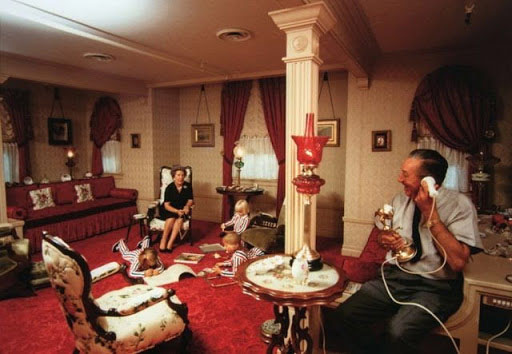
During the construction of Disneyland, a private apartment was built for Walt above the Main Street Firehouse. This gave him somewhere to stay if he needed while checking on the park’s progress. It was small but functional, with a bathroom and a kitchen unit, and designed to match the interior design of the Firehouse itself. The apartment is still exactly as Walt had left it.
In the window, Walt had placed a Victorian-style lamp. Legend has it that, when Walt went to work, he would turn it on as a signal to Disneyland cast members, and when he returned, he would turn it off. When Walt passed away, as a sign of respect, one of the cast members went into the apartment and turned the lamp off, but the next morning when they arrived for work, the lamp in Walt’s apartment in Disneyland was shining from the window.
It has stayed on ever since.
- Wikipedia on Disneyland, Disneyland TV series, the Davy Crockett miniseries, ‘The Ballad of Davy Crockett’
- Walt Disney’s Disneyland, Chris Nichols (with Charlene Nichols), Tanschen, 2018
- American Experience: Walt Disney, dir. Sarah Colt, PBS, 2015
- Walt Disney: The Triumph of the American Imagination, Neal Gabler, 2006
- Opening Day at Disneyland: Photos from 1955, The Atlantic, 24th 2019
- Disneyland’s very first guest visits every year with his lifetime pass, Daily News, 5th October 2019













